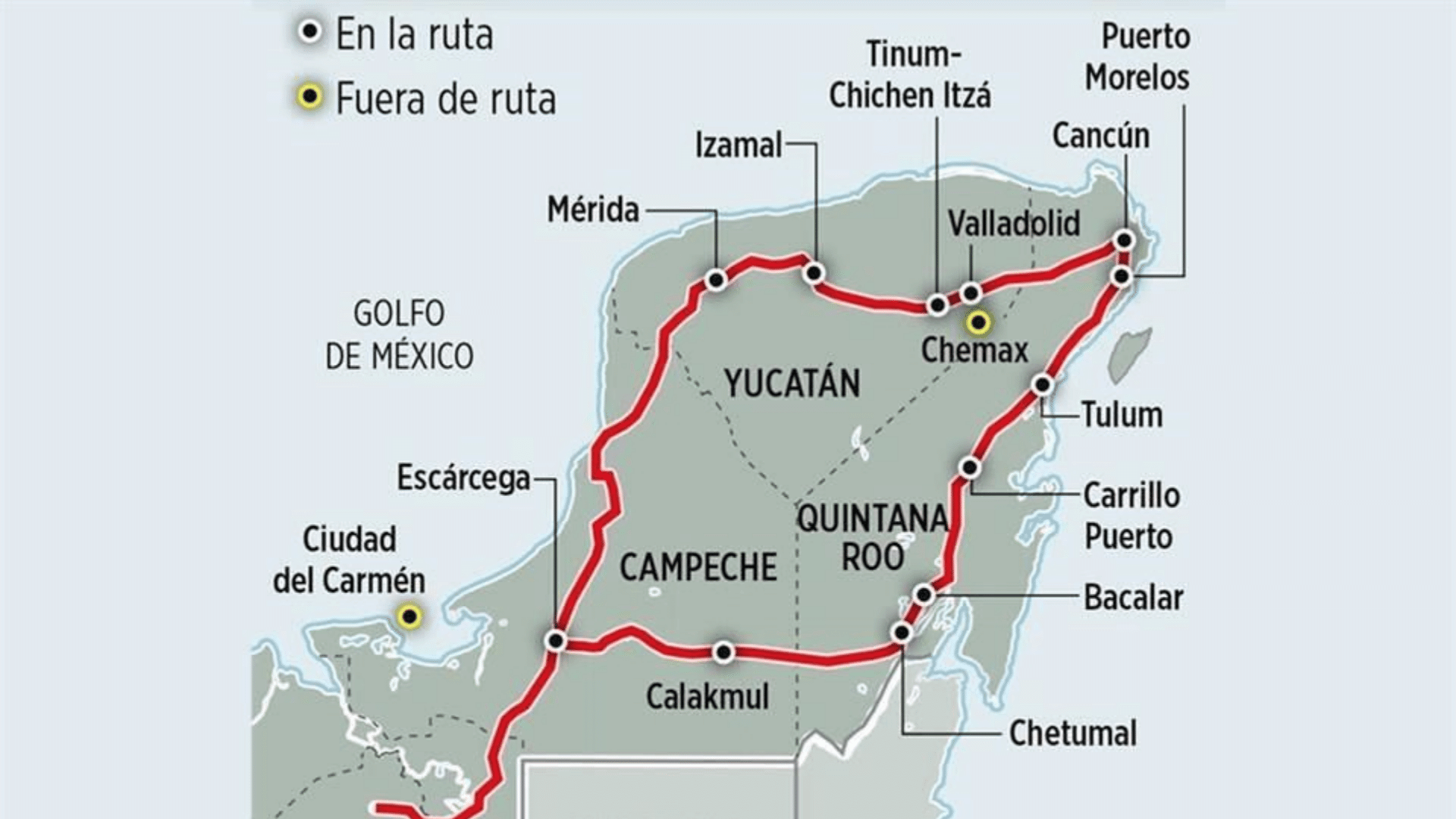Sharing is caring!
For quite some time, we’ve heard about the Tren Maya project. So, we decided to do some research and find out exactly What is the Tren Maya? In June, Yucatan Magazine posted an article with some new, computer-generated images of the train and some of the stations. The pictures show incredibly luxurious train carriages and almost futuristic platforms and terminals. Notably, this is the train that could change the way we travel around the Yucatan Peninsula. This is the 1,525km-long railway project to interconnect major cities and tourist regions of the Yucatán Peninsula in Mexico.
Therefore, here are some of the opinions and local knowledge to bring you “up to speed” (pun intended).
In this article, we’ve highlighted some of the intriguing questions and the answers about what the Tren Maya currently means for the future of Yucatan. Surprisingly, there are both interesting facts about the Tren Maya and myths surrounding the project as well.
Note, in this article, we will be using the Spanish term Tren Maya as this is what you will need when you travel on it in the near future!
Cover image credit: Meganews.mx
This article was updated in May of 2023.
What is the Tren Maya?
First things first, what are we talking about? What is the Tren Maya? If you’re new to the project then this is a high-speed train which will create a loop around the entire Yucatan Peninsula. Like never before, the glorious beaches of Quintana Roo will connect to the jungles of Chiapas, linking sites, towns and cities along the way.
It will create a network between both touristic and off-the-beaten-path locations such as:
-
- Mérida
- Tulum
- Chichen Itza
- Cancun
- Ruins of Calakmul
- Izamal
- Palenque in Chiapas
After much controversy, protests, and discussion with local communities, construction of the Tren Maya began in 2018. The route is expected to open within the next couple of years (as of Summer 2021, covid-19 permitting). It has been a plan of current president AMLO’s for the duration of his time in office. It represents his vision to use modern technology to connect cities across Mexico using an environmentally-friendly infrastructure.
Credit: Grupo REFORMA
2. Is Tren Maya only for tourists?
By linking together some of the most important places across the Yucatan Peninsula, the Tren Maya is most certainly designed to make traveling for foreigners exciting and easy. There are 3 different routes and 3 different types of carriages to choose from for your cross-peninsula journey.
The Mexicanist recently published an article announcing the names and purposes of the 3 different trains. What is particularly interesting is that 3 different types of trains have been named after aspects of Maya culture. Drawing on the ancient Maya language, the chosen words connect the project to the Maya people and the history of the peninsula.
- Xiinbal means “to walk”. This train is for local passengers with special rates to travel for work between towns and cities. Thus, highlighting ease of travel for locals.
- Janal means “to eat”. This is a restaurant train for shorter journeys between tourist hotspots. Eat meals inspired by the gastronomy of the region, from Yucatecan delicacies to seafood from the Caribbean coast.
- P’atal means “to stay”. This train is for longer journeys. Specifically designed for visitors wishing to travel across the peninsula. This takes visitors to some of the more remote destinations not readily accessible before.
3. Will Tren Maya only stop at touristic destinations?
There will be different types of stops along the route of the Tren Maya depending on the location.
For touristic and larger destinations, estaciones or train terminals are available. Terminals have a central location which is easy and convenient for passengers. The final location of the terminal in Merida hasn’t been officially decided yet (in July 2021). However, it is likely an old Art School building on the corner of calle 48 and 45 in Centro. This is close to Paseo de Montejo, Walmart, hotels, restaurants, Parque Santa Lucia, and Parque Mejorada.
Other important estaciones include:
-
- Valladolid
- Chichen Itza
- Cancun Airport
- Playa del Carmen
- Tulum
- Chetumal
- Palenque
- Campeche
Other types of stops along the route are paraderos, literally meaning ‘stops’ in Spanish. These are smaller towns such as Akumal, Tixkokob and Maxcanu. While some of these still have a touristic purpose, transport is more efficient between communities. For example, if you want to stop at the Maya ruins of Uxmal (one of our personal favourites), then you’ll jump off at Maxcanu. And, if you fancy snorkelling with some turtles. then you can hop off at Akumal.
4. What is the effect of Tren Maya on jungles and wildlife of Southeast Mexico?
A number of controversies around the Tren Maya have centered on the impact that the construction will have on the environment. This includes the communities in more remote areas of the peninsula and the wildlife in the jungles across the South East.
In regards to the environmental impact, the Tren Maya will actually be following existing rights of way. In other words, the construction of the train tracks will primarily be on land. This is already used for roads and existing railway lines which were constructed and never used, particularly in the south of the region.
In the jungles of Campeche and close to the ruins of Calakmul, railways were built in the 1930s but later abandoned. The Tren Maya uses these old tracks. Where old tracks don’t exist, additional lines are constructed along the pathways following power lines. Virtually, little to no forest is being cut down. In fact, there are many restrictions to protect the ecosystems.
For example, between Merida and Cancun, tracks run parallel to the highway. Once again, this results in very little destruction of forest areas. The train offers a much more environmentally friendly way of traveling and transporting goods across the peninsula. Additionally, while the train is not a bullet train, it is a high speed train. Along certain sections of the route, it will be for electric trains.
5. Who is in charge of building and overseeing the construction of Tren Maya?
You might already know that, since its proposal, the Tren Maya project is surrounded by controversy: a topic hotly debated by Mexicans and foreigners alike. This is considered to be one of AMLO’s legacy projects as President of Mexico.
It comes as part of his mission to:
-
- Drive forward Mexico’s self-sufficiency
- Build infrastructure that Mexico has never seen before
However, it is not surprising that many are skeptical of the project. Particularly, after the disastrous collapse of a metro bridge in Mexico City in May 2021. Sadly 26 people lost their lives and investigations suggest that the collapse was due to poor construction of the bridge.
Therefore, you might be surprised to learn that the construction of the Tren Maya is being overseen by the United Nations, in particular the United Nations Office for Project Services. In fact, in order to move forward with the project and make it happen, the UNOP had to approve everything; the design, materials, workforce etc. Therefore, the development of this project has been under strict regulations from the very beginning. Under the watchful eye of UNOP…
6. What are the myths about the Tren Maya?
Myth 1: It will never actually happen.
Notably, work on the train route started back in 2018 and is supposedly due to finish in 2024. While work might have been set back slightly due to Covid-19, the plan is still very much in motion. AMLO even visited parts of the railway back in the Fall of 2020. Recently, progress also slowed down slightly due to the discovery of historical artefacts. We are in the Maya Kingdom, after all!
Myth 2: The local communities don’t want the Tren Maya.
Yes, there are many people who do not want this project to continue. However, the Mexican government has worked closely with the communities affected by the project. They have also conducted many consultations with municipalities across the peninsula. More surprisingly, support for the project has grown strong amongst these communities. This is mainly due to the positive impact of tourism, work opportunities and travel conveniences the train network can bring. There is still opposition but it is not in such strong numbers like before.
Myth 3: It’s destroying the wildlife!
Another hotly debated topic is the protection of wildlife. You ask, “But what about the jaguars and the spider monkeys?” There is a plan for a number of tunnels under the train lines and also large bridges covered in foliage for animals to cross safely. At the moment, there are not many crossings for wildlife across the state highways. The railways are being designed to combat this problem.
7. What are the changes for Mérida with Tren Maya?
Hopefully, you already know we love all things Mérida! It’s hard to know what effects the Tren Maya will have on Mérida. However, the city will continue to grow and develop as it has been doing since before the pandemic.
Particularly, Mérida will become connected to other smaller towns and cities nearby. Therefore, travel becomes much faster. This can postively impact smaller towns increasing opportunities for development; opening up freedom for business and trade. The headquarters of the Tren Maya project are also in Merida; creating a number of exciting jobs.
Final Thoughts on What is the Tren Maya?
Ultimately, you can make up your own mind about the Tren Maya. While we may not have answered all of your questions, we attempted to provide an overview for you to begin your own research. Of course, we try to remain unbiased in this article, we can say for sure that the future of Yucatan, Quintana Roo, Chiapas and other states looks very different. Take an exciting trip around the Peninsula like never before, much like interrailing in Europe!
Here are some of the things we are quite excited about:
- If you’re staying along the Riviera Maya, you can take a daytrip to Mérida and vice versa.
- You can travel to the incredible archeological sites of Calakmul and Palenque. Avoiding some of the current risks like taking a 16-hour bus ride or driving your car along badly-maintained highways is more than helpful.
- There will be job opportunities across the states. . . not just with the Tren Maya project but other projects as well.
- Companies can transport goods much faster and more safely between states, reducing road traffic and highway accidents.
Are you pondering the thought we are being catapulted in a new and exciting future? Let us know your thoughts and perspectives. Of course, for more information, visit the official website: https://trenmayaa.com/en/news/









